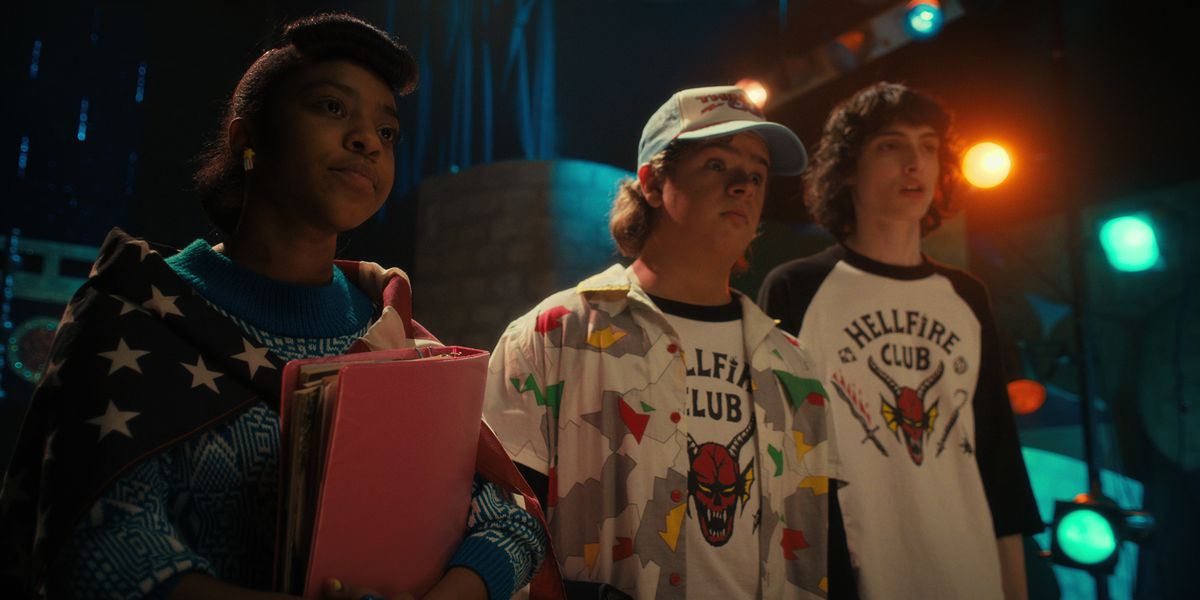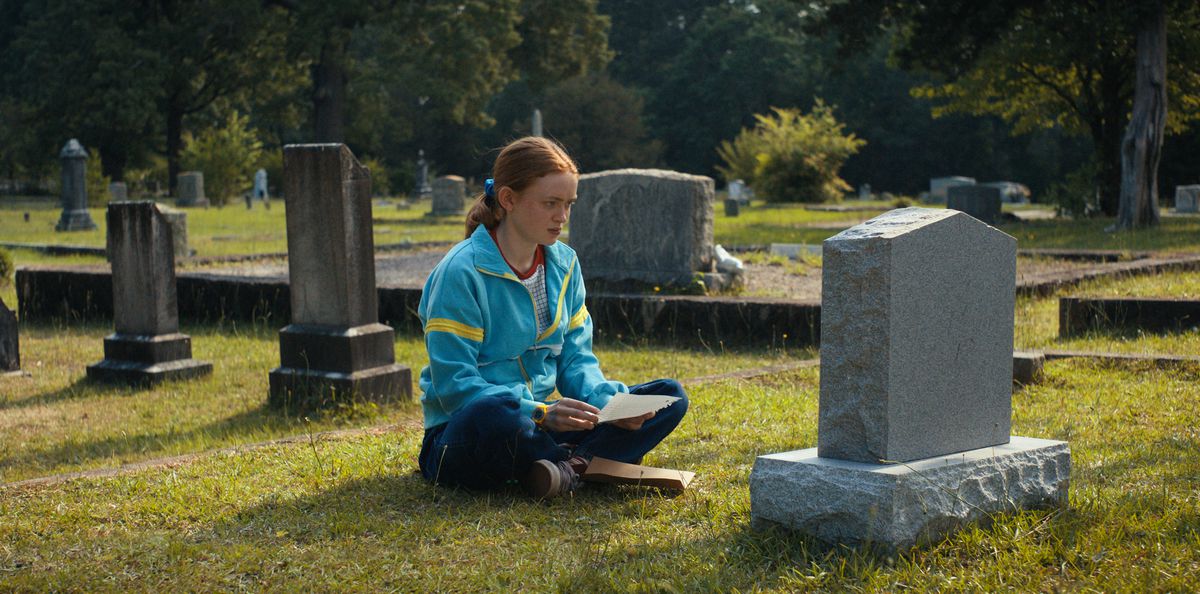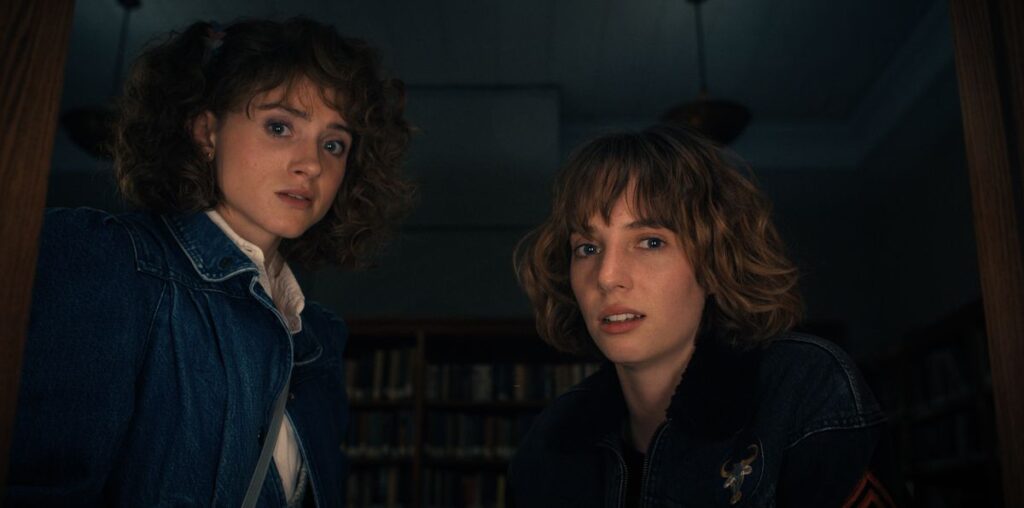Stranger Things revels in the nostalgia and the aesthetic of the 1980s — but that nostalgia is presented in a very limited scope. Throughout its four seasons, the Netflix show celebrates what little boys who grew up in predominantly white suburbs in the ’80s loved, and not much else. It makes sense, considering the creators themselves were little boys during that decade. The Duffer brothers have been open about their influences and all the references in the show, which have translated into the main characters’ passions: Ghostbusters, Dungeons & Dragons, and Dig Dug, to name a few.
None of those things are blatantly anti-girl, but they’re still tailored overwhelmingly to boys. And yes, there are plenty of ’80s hallmarks in the show that are more universal concepts, like mega-malls and New Coke. But Stranger Things has a distinct lack of ’80s pop culture elements that girls specifically would have enjoyed. Where are the fashion plates? The Jem and the Holograms or Barbie dolls? The stacks of Sweet Valley High books? There may be one or two Strawberry Shortcake costumes in the background, but there is a lack of other girly things because most of the main female characters in the show simply prefer the things that the boys enjoy. It speaks not just to how the female characters are treated in the show, but also the greater culture phenomenon of elevating boyhood interests over girlhood ones.
But with the introduction of Lucas’ sister, Erica (Priah Ferguson), as a main character last season and an expansion of Max’s interests this season, Stranger Things has slowly started to acknowledge that girl things are worth remembering too. Well, kinda.
[Ed. note: This essay contains some spoilers for Stranger Things season 4 part 1.]
Image: Netflix
What we talk about when we talk about nostalgia
Stranger Things, to its credit, doesn’t outright dismiss girly interests from 40 years ago; it just barely includes them. In a show so overwhelmingly built on nostalgic references, that becomes a glaring omission. There are a decent amount of female characters, but we rarely hear about their interests beyond what the boys are already interested in. They’ve all been presented to be “Not Like Other Girls” — even if the show hardly has any girly girls to compare them to — or “Cool Girls,” which are both tropes that focus on female characters who can keep up with the boys and also reject traditional feminine interests. In this case, it’s less of a rejection and more like those things don’t even exist.
Having grown up in a sterile research facility, Eleven (Millie Bobby Brown) has no interests of her own, so everything she learns to love comes from Mike. When Max was first introduced in season 2, the boys could hardly believe that she was a cool skateboarder who beat Dustin’s high scores at the arcade. The older women don’t really have interests beyond romance, school, work, or being a mom (in Joyce’s case). In fact, after four seasons, we don’t even know what Nancy (Natalia Dyer) likes to do beyond school and work (except this season, we learn that she has a Tom Cruise poster in her room, so that’s something). What we do know about Nancy — the most stereotypically feminine of all the girls — is that she is “different” than the popular girls that Steve hangs out with.
Image: Netflix
Eleven, Max, Robin, and even Dustin’s hacker GF, Suzie, are the type of cool girls that boys in middle school and high school want to hang out with — their interests either mesh perfectly with the boys’, or they can be taught to love the same things that the boys do. They aren’t loud about their own interests, and even though they like the same things the boys do, they always do it in a very acceptable, boy-friendly manner. Yes, there are certainly girls out there who check all these boxes; but when it’s every girl in the show, it makes a statement about what type of girls are worthy of inclusion in shows. Stranger Things is one of the most popular shows on Netflix, which means that its limited depiction of female characters gets a bigger platform than more nuanced portrayals in shows like Julie and the Phantoms, Teenage Bounty Hunters, and The Baby-Sitters Club, which were axed after one or two seasons.
It’s not that girls can’t enjoy boy things; they can and they should! And to be fair, the male characters in Stranger Things don’t gatekeep their interest from the girls in the way that sadly happens in real life. It’s more so the fact that the boy interests are the ones that society deems worth remembering, making shows about, and rebooting time and time again. Even if girls can enjoy these boy things, attempts to feature them within these stories (be it Ghostbusters (2016) or Rey wielding a lightsaber) are overwhelmingly met with mobs of haters on the internet pushing them out again. Girl things aren’t worth remembering, and adding girls to boy things ruins their “sacredness.” The fact that Stranger Things overwhelmingly holds up these boy things, while ignoring the girl things, only emphasizes this double standard. It is likely just a blind spot instead of something maliciously intentional. After all, while the Stranger Things writing room does have an almost even number of men and women working on the show, only eight out of the 34 episodes have a woman listed as the writer.
(Token) Girl Power
On another metatextual note, the first few seasons of Stranger Things also reinforced another annoying stereotype about 1980s media: the Token Girl. Granted, the trope of having one girl in a group of boys isn’t something that is going away soon, but it definitely was even more common in the ’80s. That’s slowly rectified on Stranger Things as more girls joined the series, though they’ve only recently started to actually get along and consider each other friends. But it was Erica who really started to shift those dynamics, especially when it came to just how she got along with the boys and what she liked.
In a sea of female characters who mostly care about boy things (or don’t really care about anything), Erica is a breath of fresh air. When she became a major character in season three, her passion for math, capitalism, and My Little Pony immediately put her at odds with the rest of the cast. Her interests aren’t dismissed, and Dustin even argues that her love of My Little Pony is actually nerdy (which, within the show, is him basically telling her it’s cool and worthy). There’s even an official Stranger Things My Little Pony because of Erica.

Image: Netflix
At the end of the third season, Will leaves her his D&D stuff, and by the time season 4 kicks off, she’s fully embraced her nerdy side. However, she doesn’t leave her girly interests behind. She fills in for her brother when he can’t make the D&D club’s final campaign due to his championship basketball game. When Hellfire Club leader and Dungeon Master Eddie starts to grill her about her character, she fires back that she has a half-elf rogue named Lady Applejack.
Sound familiar? Applejack is one of the first generation of My Little Pony characters and also one of the stars of the first ever My Little Pony movie, Rescue at Midnight Castle. Erica may like boy things too now, but she’s brought her love of a girlhood toy to that traditionally boy-dominated (especially at the time) game. And she’s not letting anyone tell her she can’t.
But Erica isn’t the only example of embracing more feminine interests. Max gets more screen time this season, and her love of Kate Bush becomes a pivotal plot point. After her stepbrother’s death, she’s more or less isolated herself from her friends and now obsessively listens to Kate Bush’s “Running Up That Hill (A Deal With God)” on her Walkman. “Running Up That Hill” is the lead single on Bush’s 1985 album Hounds of Love and one of her most popular songs (and incidentally, a song about differences between men and women). Kate Bush is a popular artist, and she certainly was back in 1985 — but she still dealt with her share of misogyny, with many male music critics at the time put off by her unabashed femininity and dismissing her as a privileged young woman making pop music. Male music critics are still quick to dismiss young female artists (and the artists that young women love).

Image: Netflix
Max finds solace in Kate Bush’s music, and while her friends are giving her space because of her own brooding, they don’t dismiss that passion of hers. And Kate Bush ends up saving her life from Vecna’s curse, the synth notes of “Running Up That Hill” snapping her out of the monster’s nightmare realm in one of the best sequences of this season. Later on, Lucas says that he’s now a mega-fan of Kate Bush because she saved Max’s life. It’s one of the few — if only — instances of a boy in the show saying he’s now into a thing one of the girls likes.
In terms of nostalgia-fests, Stranger Things is no Turning Red, with its unapologetic embracing of the minutiae of girlhood joy. The show still mostly revolves around references to boy-tailored media. These two little nods may get lost in the grand scheme of things. But they’re at least something, which is a far cry from the nothing in the show’s first two seasons. Considering there’s only two episodes left in the season, it’s unlikely that the characters will save the day by channeling the power of She-Ra or Rainbow Brite — but at least we have the irrefutable fact that Kate Bush’s music has magical power.
Stranger Things season 4 part 1 is available on Netflix now.

